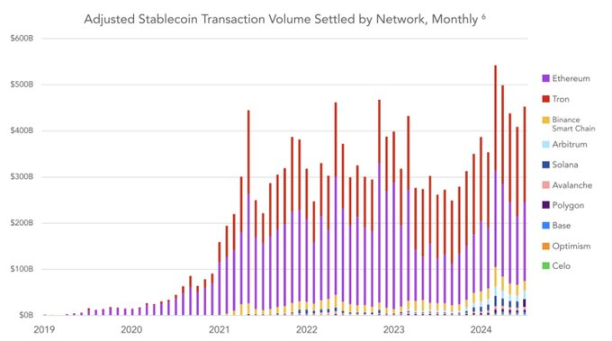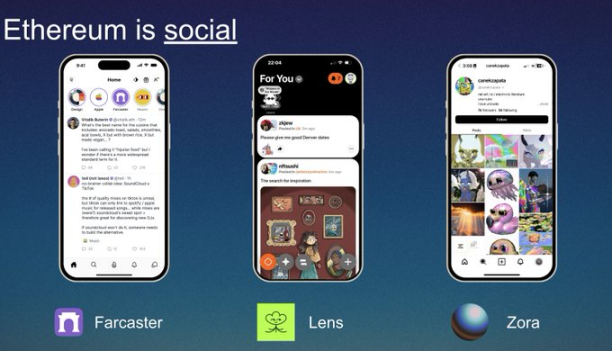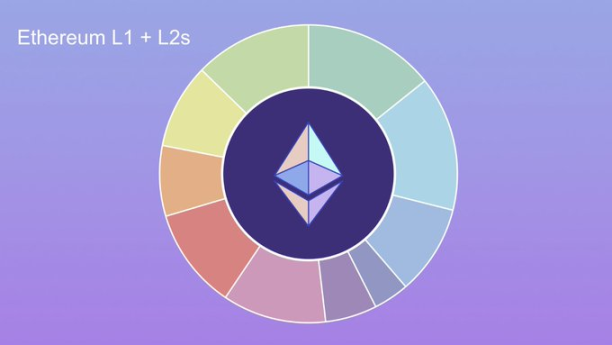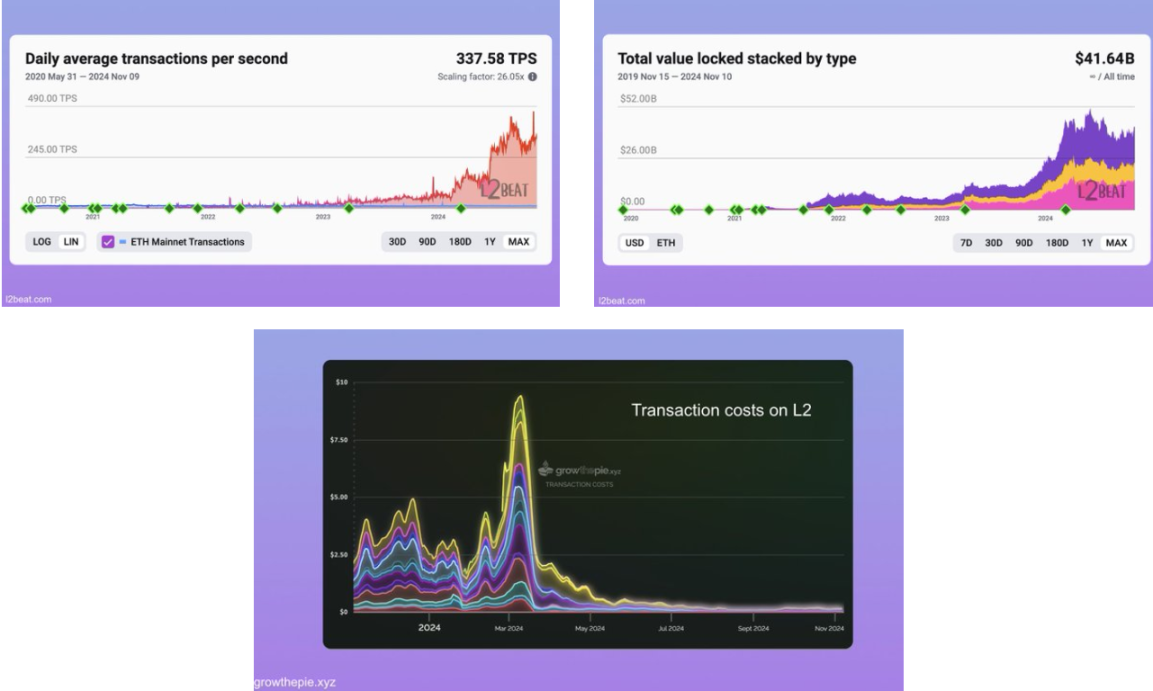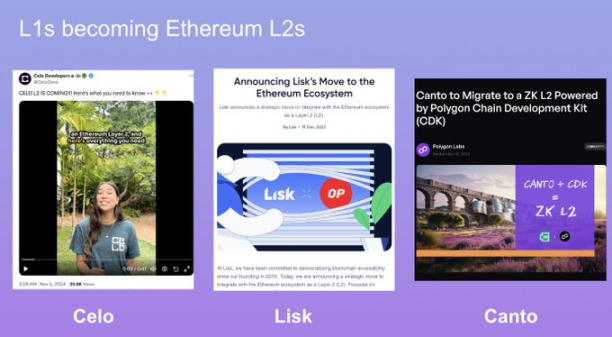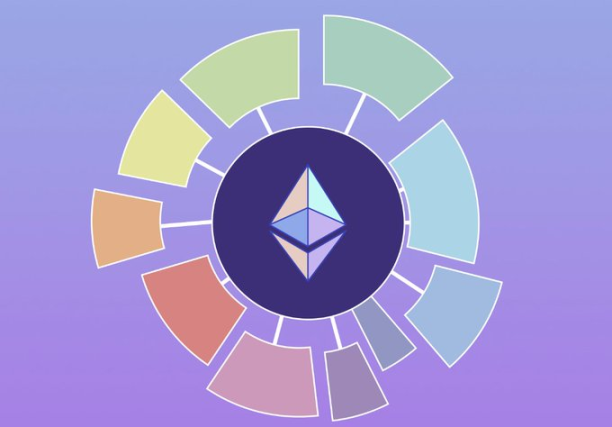Original article by Josh Stark, Ethereum Foundation
اصل translation: Pzai, Foresight News
What happened to Ethereum in 2024?
We can divide it into 3 topics:
-
Applications: An ecosystem of products and services built on Ethereum.
-
Infrastructure: The technology that makes it all possible.
-
Community: You, me, and everyone else who uses or contributes to Ethereum.
ایپ
Ethereum is changing the world because it solves problems for people. Developers around the world use Ethereum to build things that users want. But Ethereum is more than just one thing – its a platform that serves a multitude of use cases. One of those use cases is stablecoins. Stablecoins give everyone the freedom to transact: to send money back home to family or for savings. I think they are still underrated – stablecoins fundamentally advance human freedom around the world.
Stablecoins exist on many chains, but the Ethereum ecosystem has a unique role as the venue for the circulation of most existing stablecoins. The number of stablecoins in the Ethereum ecosystem now competes with major payment processing networks including Mastercard and Visa.
Behind all these statistics are a variety of stories and use cases, such as Bitso using stablecoins on Ethereum to provide faster and cheaper remittances in Latin America, and Pintu using stablecoins to provide better savings products for users in Indonesia.
Ethereum is also the birthplace of DeFi. These applications leverage the unique properties of Ethereum to build financial products that cannot be discriminated against or shut down, and give people greater control over their funds. DeFi was invented on Ethereum, and the Ethereum ecosystem remains its home. Today, about 60% of the value in DeFi applications is stored on Ethereum or Ethereum L2.
Behind these huge numbers are real benefits for ordinary people around the world. In Mexico, EthicHub uses DeFi to connect small business owners such as coffee producers with lenders who provide the capital they need to grow their businesses.
There is “much more” DeFi on Ethereum than I can cover in this talk. Thank you to all the teams, companies, DAOs, and independent developers who are building this ecosystem. Stablecoins and DeFi are two of the earliest use cases on Ethereum, and they continue to mature, grow, and scale. But Ethereum is also a blockchain ecosystem that produces new things.
New things like the social network Farcaster, Lens, and Zora use Ethereum to let users control their own identities and even share in the growth of the platform. There are also new games that use Ethereum technology to provide players with new experiences, such as EVE Frontier, a new MMO game where the physics of the game world are built in the form of smart contracts, on top of which players can build autonomous systems.
Decentralized identity systems like ENS and AnonAadhaar provide users with options that centralized or traditional IDs don’t offer. Real-world infrastructure like Glow leverages the Ethereum ecosystem to incentivize hundreds of solar farms.
The huge breakout success of prediction markets, such as Polymarket and the Polygon team are showing the world what is possible to build open systems on-chain. I am very excited about Polygon PoS’ transition to Ethereum verification very soon. One thing I love about the Ethereum ecosystem is that Ethereum is the place where ideas can enter production. Prediction markets are an idea that has been formalized and debated in academic work for decades. It was on Ethereum that early experiments led to breakout moments.
Quadratic funding is also another idea that was formalized over the years in academic work. Multiple teams in the Ethereum ecosystem then took these ideas and built products that serve users around the world today.
Ethereum is a platform for developers. By 2024, Ethereum will be the “best” platform for developers in the کرپٹو ecosystem. This is even more true when you look at the data on the chains that project founders are building or “interested” in building:
A big reason for this is the extremely deep and complete developer tooling ecosystem on Ethereum, which builds and maintains everything developers need to launch, ship, and build applications that can securely scale to millions of users around the world.
When we take a look, what do we see in the application layer of Ethereum? Ethereum has the oldest and most mature use cases: currency, stablecoins, DeFi; Ethereum is also where new things are born, and Ethereum is the best developer ecosystem. Looking around our ecosystem and seeing the confidence and excitement in every use case area, I can fairly say that Ethereum aims to keep growing in every dimension.
انفراسٹرکچر
Behind every application is a technology layer, which includes the Ethereum L1 and L2 networks. Over the past few years, the Ethereum ecosystem has invested heavily in improving this infrastructure. Ethereum is the only blockchain that has enough real demand and pushes it to its limits, and it is difficult but necessary to achieve true expansion without compromise.
Most of the investment is related to L2 or Rollups. I wont go into detail here, but I want to provide a very simple mental model that anyone can understand. The idea behind L2 is simple: the core is Ethereum L1 – the native smart contract platform and the most secure blockchain in the world. But L1 has a limited surface area available to developers and users, which means it can be relatively expensive. The outer layer is Ethereum L2, which are networks built on top of L1 and expand their surface area outward. L2s provide more available space for developers and users, which reduces costs, but because they can be connected to Ethereum in a specific way, they are very secure.
Now, we can’t get complacent — there’s still a lot of work to do to complete the ecosystem’s L2 roadmap. But right now, we have some very strong evidence that this strategy is working.
The first proof is: people are using them! Real TPS on Ethereum L2 has exploded this year, as has TVL in L2. Meanwhile, fees remain low after a key network upgrade earlier this year (EIP 4844). On Ethereum L2, you can send $1, $100, or even $1 million to anyone on Earth for less than a cent.
The second piece of evidence is that developers are beginning to take advantage of the fact that different L2s can be customized for different purposes. This means that Ethereum can absorb innovations from any other ecosystem and provide specific environments for different use cases. The third piece of evidence is that institutions and enterprises are launching L2s and bringing their communities into the Ethereum ecosystem. Ethereum is helping centralized institutions become more decentralized and bringing millions of people onto the chain.
Finally, over the past few years, we’ve even seen some former L1s decide to transition to become L2s in the Ethereum ecosystem to take advantage of Ethereum’s security and community. We’re glad you’re here – welcome to the Infinite Garden!
But as I said, we are not done yet. We still have two big tasks for the ecosystem: taking off the training wheels (to get to the final form) and building interoperability
Currently, most L2s are not in their “final form” and they would benefit from as much security and decentralization as possible. In fact, the picture I showed earlier is more like this:
We often refer to these as “phases” and you can learn more about them on L2Beat , where each L2 is progressing towards Phase 2. There is a lot to be proud of here, with two full EVM L2s – Arbitrum and Optimism – reaching Phase 1 so far, and more are sure to follow soon. Finally, thank you L2Beat for tracking, measuring, and publishing information about the progress of each L2 towards Phase 2. You help the Ethereum ecosystem better understand itself and hold the community accountable to our ambitious goals.
The second mission is interoperability and user experience. Using L2 right now is not as easy as it should be. Moving from one L2 to another and sending to someone across the ecosystem – the experience is far from what it should be. Instead, it needs to look more like a simple, interoperable network that feels like an ecosystem because it is an ecosystem. 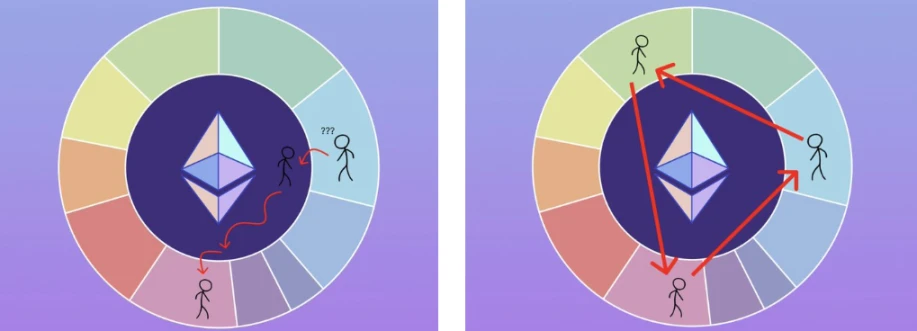
Fortunately, there are hundreds of people in the ecosystem working to make this happen. Soon we will have addresses that can be used everywhere, can be easily sent from one L2 to any other L2, and we will be able to easily verify L2s with light clients.
برادری
To understand the state of Ethereum today, we have to talk about ourselves! The Ethereum community has become so large and broad that it is hard for us to comprehend it. We can be users of Ethereum applications, ETH holders, application developers, protocol researchers, client developers, L2 developers and L2 commentators, stakers and re-stakers, Degens and Regens, cypherpunks, activists and radicals, artists, musicians and writers, educators, translators and students, complete newbies and veterans, and so much more.
One incredible feature of the Ethereum community is that it is truly international. There are multiple communities of users and enthusiasts in every region of the world, as well as developers contributing to applications, L2, and RD. It doesn’t get much better than that. But there is another quality to our community that is not so obvious. I don’t have a fancy chart to prove it, but perhaps you’ve noticed. Over the past few years, our community has not only grown larger, but also deeper, it has matured.
By 2024, many of us understand that this is not a sprint, but a marathon. We are laying down roots and preparing for the long haul. We are building enduring organizations and companies, we are training the next generation, and we have gained the confidence to plan for success.
So — what’s the story of Ethereum in 2024? I see the beginning of a virtuous cycle. We’re growing, and that growth tests us and pushes Ethereum’s infrastructure to its limits, and then we build that way. Better infrastructure can do bigger things, and that unlocks a new phase of growth. The interplay between adoption, growth, infrastructure, and growth again attracts a community of people who need what Ethereum has to offer, people who want to plant their own seeds, and people who want to build entire communities for the next generation.
We can’t be complacent. There are a lot of hard problems to solve. But remember: Ethereum is getting the hard ones first because it’s the furthest along.
This article is sourced from the internet: Looking Ahead to 2024: A Year in Review of the Ethereum Ecosystem
متعلقہ: 9 قدیم وہیل جاگ رہی ہیں، آخری کرپٹو بیل رن کا اشارہ؟
Original锝淥daily Planet Daily (@OdailyChina ) مصنف: وینسر (@wenser 2010 ) فیڈرل ریزرو میں 50 بیسس پوائنٹ سود کی شرح میں کمی کی خبر کے ساتھ، کرپٹو مارکیٹ نے اتار چڑھاؤ کے طویل دور کو ختم کرنا شروع کیا اور آہستہ آہستہ بڑھنے لگا طویل غیر موجودگی: بٹ کوائن ایک بار $64,750 کے ذریعے ٹوٹ گیا، اور Ethereum ایک بار $2,700 تک پہنچ گیا۔ اسی وقت، بہت سی قدیم کرپٹو وہیل جو غائب ہو چکی تھیں، حال ہی میں آہستہ آہستہ منظر عام پر آئی ہیں۔ یہاں تک کہ مائنر والیٹس جنہوں نے 2009 کے اوائل میں Bitcoin کی کان کنی شروع کی تھی، انہوں نے اپنی آن چین اثاثہ منتقلی کی کارروائیاں شروع کر دی ہیں، جو لوگوں کو مستقبل کے بازار کے رجحان کے بارے میں مزید گھبراتی ہیں۔ کچھ لوگوں نے یہاں تک کہا: یہ سائیکل خوردہ سرمایہ کاروں کے لیے آخری بیل مارکیٹ ہو سکتی ہے۔ یقیناً، ابھی فیصلہ کرنا بہت جلد ہو سکتا ہے۔ عام طور پر سیارہ…
